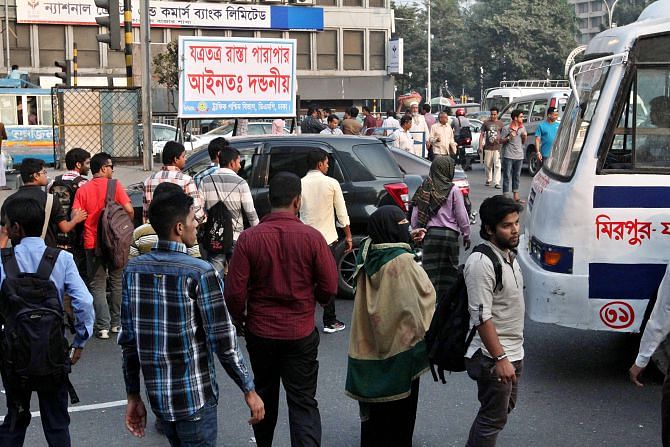We have little room for experiment
We have little room for experiment

DHAKA Metropolitan police (DMP) has hit upon a novel idea to discourage jaywalking in the city. Part of a weeklong campaign at a pilot level, a mobile court will operate between Rupashi Bangla Hotel and Farmgate points of the city from Tuesday to control the illegal pedestrian habit to cross streets in a random manner at different road intersections or even at non-intersections by jumping over the road-dividers without regard to traffic laws. The court will penalize individuals found breaking traffic rules in this way either by imposing a fine of Tk.200 on them or by sentencing them to a six months' prison term. The DMP, however, does not say what will happen after the pilot programme is over. Will pedestrians along the section of the Kazi Nazrul Islam Avenue in question then be left to their own devices again?
The entire idea makes little sense. It does not even look serious.
First come to the legal provisions to penalize the jaywalker. How do you match Tk.200 in fine with six months' jail? Does it not seem out of proportion to the nature of the offence? If the argument is that it aims to strike fear in the heart of the would-be jaywalker, it still does hardly stand to reason. Law is not a plaything. It has to be well-thought-of, rational and meant to be effective. But from the very beginning the whole exercise looks very tentative.
The metropolitan police chief while announcing the weeklong anti-jaywalking drive followed by a three-day awareness programme, mentioned the intolerable traffic chaos created everyday at the road island with fountain in front of Sonargaon Hotel. The stream of pedestrians gathering there throughout the day is certainly a huge obstacle to smooth movement of vehicles at that point. But what options are left to those who throng there from either side of the street than to use that intersection? Otherwise, say, those coming from the Panthapath or from Sonargaon road end will have to cross the Panthapath from its Southerner side over to its northern lane and that, too, illegally and then brace for the long walk jostling and elbowing through the crowded pavement all the way up to the Purnima cinema where the lone underpass in the entire area is situated. After going over to the other side of the street through the underpass, they will again have to use the crowded pavement and move towards the Sonargaon Hotel point to begin their eastward journey. Those who want to move westward from Sonargaon Hotel towards Patnthapath will have to take the reverse route and face a similar ordeal. Then how can one blame these people for using the Sonargaon fountain crossing illegally when there is neither a foot overbridge nor an underpass at that particular crossing?
If truth be told, the foot overbridges and underpasses spanning major city streets are rather few compared to the number of pedestrians shuttling between the two sides of different streets everyday.
Now come to the case of those who refuse to use the overbridges or underpasses. That is certainly a bad habit and deserves to be punished. But what about the old people and others who are physically handicapped or even have heart ailments? Are our footbridges or underpasses friendly towards the particular needs of those pedestrians? The steeply rising stairs of, especially, the overbrisdges pose a huge risk to the heart patients. Moreover, the overbridges are not only in adverse possession of hawkers and beggars, they in some cases turn into a veritable den of thugs and muggers. Shouldn't the city fathers think of increasing the number of overbridges and underpasses as well as make those more user-friendly and secure for the public?
Tokenism or adhoc-ism is no answer to the colossal problem we are talking about. While the need to train the pedestrians and other road users on the discipline and culture of a modern city cannot be overemphasized, one cannot also be oblivious of the harsh realities on the ground. Do the pedestrians of the city have any uncluttered and unoccupied walkways for them to move freely and safely? Or take the case of unruly buses. What measures have the authorities taken so far to discipline the buses that stop at undesignated spots on the streets causing passengers waiting to get on and get off such buses run in a chaotic manner in the middle of the road? And are not these undesignated bus stoppages also the points where pedestrians are in a mad rush to cross the roads, sometimes jumping over the traffic median, risking their lives?
The authorities need to accept the fact that the erratic pedestrian behaviour has more to do with the lack of better alternatives than any ignorance of proper metropolitan culture on their part.
With disproportionately more vehicles than are roads and a size of population that the city can hardly accommodate, we cannot expect an ideal behaviour particularly from its less privileged citizens, let alone pedestrians. Even so, we believe, the city-dwellers are law-abiding. And for any measure meant to make them respectful of law of the road, it has to be pragmatic and sustainable. And in such a desperate situation, there is little room for experiment.
The writer is Editor, Science & Life, The Daily Star.
E-mail: sfalim.ds@gmail.com